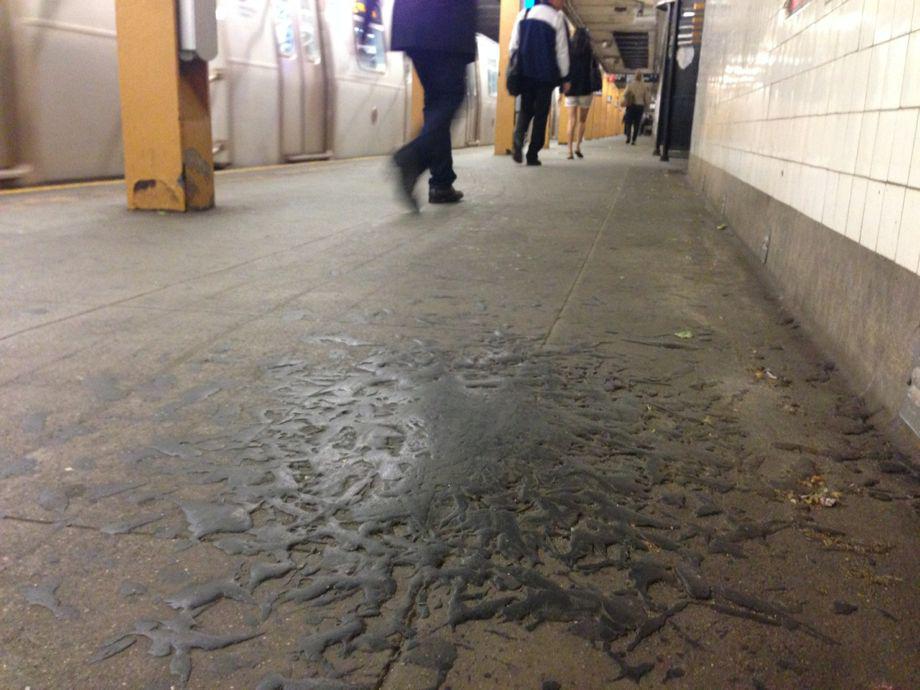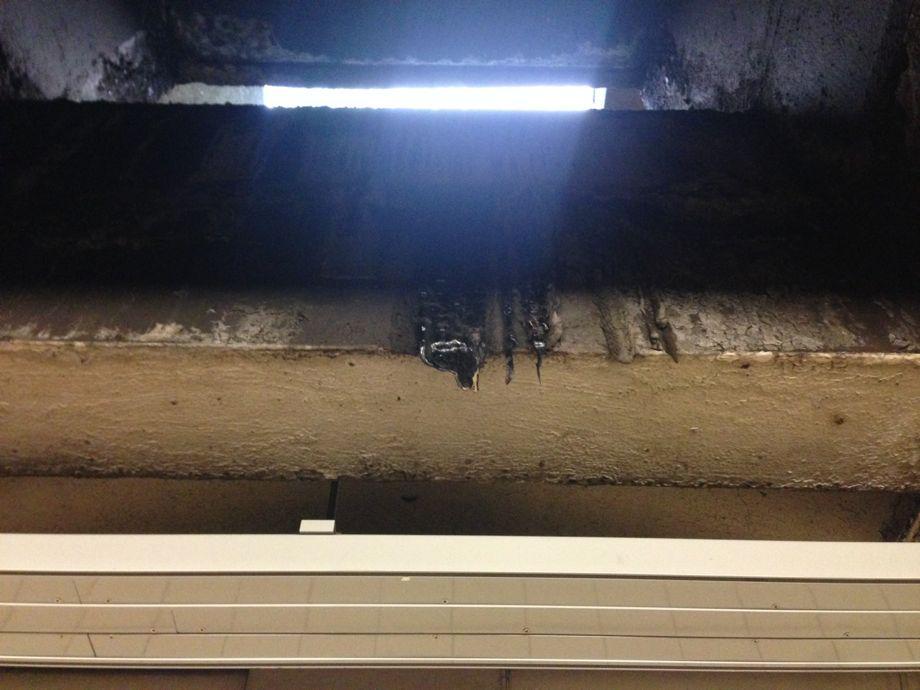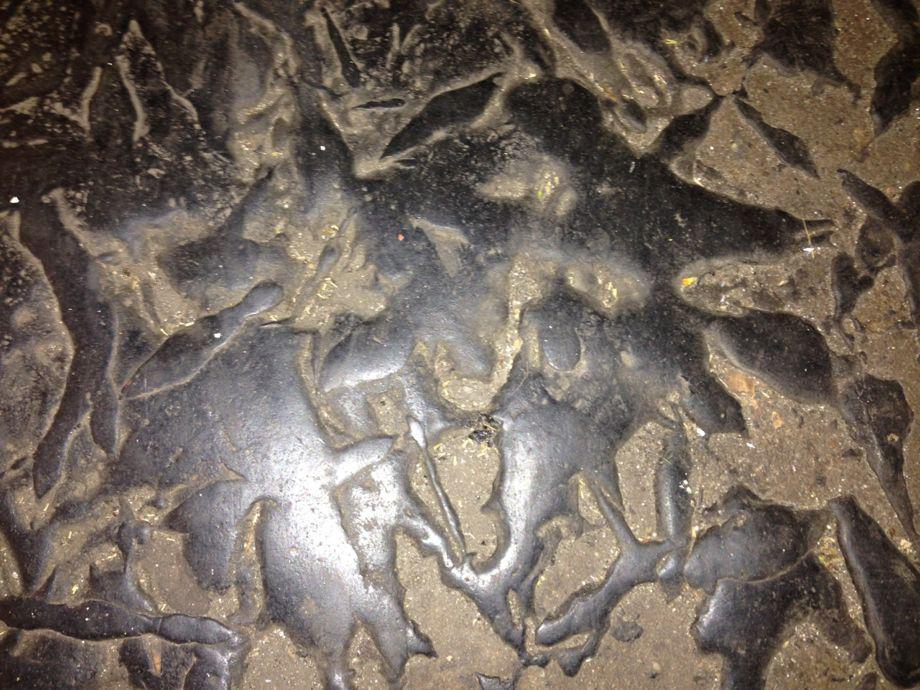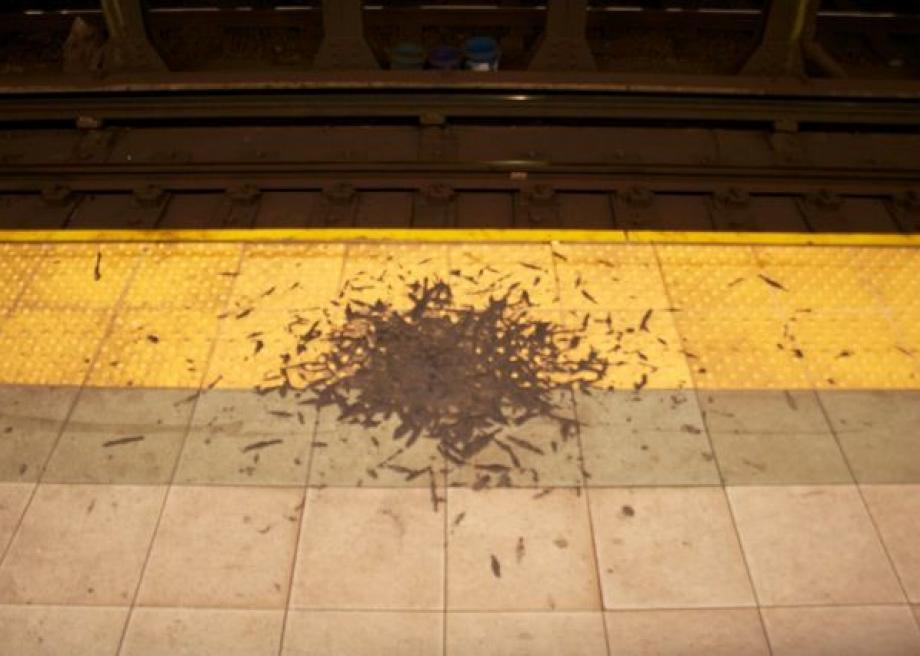What’s That Thing is Slate’s column examining mysterious or overlooked objects in our visual landscape. To submit suggestions and pics for future columns, drop us an email.
Take a look at that pile of gunk above, one of many similar accumulations found on subway platforms in New York City.
What is it? The spoor of some Chewbacca-like, subway-surfing urban Sasquatch? The first worrying, basaltic flickers of some Pompeii-caliber volcanism? A new sculpture by Lynda Benglis?
Finding the source of what we’ll call Urban Gunk Accretions, or UGAs, took more effort than I expected. Station personnel didn’t seem to know. I contacted New York’s Metropolitan Transportation Authority, who said they’d get back to me. Meanwhile I asked a few New Yorkers for their thoughts. Responses—aside from stepping warily away from me—included “Ugh!” “Keep it classy, NYC!” and “Nasty nasty.”

Courtesy of Mark Vanhoenacker
Next I turned to Sam Schwartz (aka “Gridlock Sam”) figuring what he and his staff don’t know about public transportation in New York City isn’t worth knowing, let alone stepping around. Schwartz and Harris Schechtman, director of transit planning at Schwartz’s firm, were puzzled but intrigued, and started their own informal investigation.
I also contacted Jason Chin-Fatt, who works with the venerable Straphangers Campaign, a transit users advocacy group. Chin-Fatt pointed me to his organization’s recent report on the “grim and dreary” state of subway platforms. But the Straphangers Campaign doesn’t yet track UGAs—perhaps the organization is overly focused on calling out rats and exposed wiring?—and Chin-Fatt wasn’t sure what UGAs are or what causes them. “Please keep us informed if you are able to find out what that substance is,” he said. “It looks hideous and luckily no passenger had that fall on them during their commute.”
Eventually the MTA’s helpful Marisa Baldeo put me in touch with Branko Kleva, assistant chief of the Division of Stations for NYC Transit, who told me that what I call UGAs are what he calls tar or mastic (Greek, via Latin and Middle English, for “gum”; think “masticate”). Mastic is used to seal and waterproof the tunnel structures. When the mastic warms up, especially in summer—either from the heat outdoors, or the heat that accumulates on subway platforms (much of it caused by the air conditioning inside the subway cars)—it can start to flow and drip down from the roof of the tunnel onto the platforms below. In fact, you can often see stalactites (Greek: “that which drips”) of mastic forming on beams or structures right above the platform areas where a UGA has accumulated.

Courtesy of Mark Vanhoenacker
I asked Kleva if these sealant leaks were related to the water you sometimes see pouring out of the ceilings of subway stations, especially in heavy rain. “Not really,” Kleva explained. “Both water leaks and mastic find their way into the system through whatever cracks or pores exist in the concrete.” Rain comes “through areas where waterproofing has been compromised by age or wear and tear.” Mastic, in contrast, “tends to seal the cracks” it moves through.
It’s hard not to be a little concerned that molten tar is pouring down from the ceilings of America’s busiest transit system (see: Mongols, Carthaginians, and early thermal weaponry). But it’s not that hot. And anyway, the MTA’s Baldeo says UGAs are “nothing to be alarmed about.”
What’s the future of UGAs? Kleva points out that new subway tunnels use new, different kinds of sealants that are less likely to form UGAs. But repairing older tunnels is prohibitively expensive. While small repairs can be undertaken from inside the tunnel, it’s typically only when the street is dug up for another reason that the tunnel is comprehensively resealed. “Whenever we open up the street, we install new waterproofing,” he told me.
Global warming will surely mean—in addition to scorched croplands and rising seas—more UGAs. For now the only way to deal with them, says Kleva, is to “scrape them off, or powerwash them”—and perhaps put a drip pan in to stop new formations. It’s easy to be cynical about the cleanliness of the subway, but in fact when I returned to the location of one UGA to take more photographs, it had been carefully and almost entirely removed.

Courtesy of Mark Jones

Courtesy of Mark Vanhoenacker
I was almost sad to see it gone. Sure, UGAs are nasty. But they’re kinda cool, too. They have both a sands-through-the-hourglass quality (“Like the melting tar that drips from the roof of the subway, so are the days …”) and the sense of an urban environment that is flowing on timescales a bit more geologic than a typical New York minute. UGAs also recall the famous pitch drop experiments (here’s a video of a moment 69 years in the making).
And if you look at UGAs closely and repeatedly, they began to take on a strange beauty, as if I was looking down at the surface of some distant volcanic planet from high above it, or indeed at a work of art. If only an exhibit description had been affixed on a nearby station wall …

Courtesy of Mark Vanhoenacker
See something out there—or up there, melting through the ceiling—and wonder what it is? Send a picture or a description to whatisthat@markvr.com.
